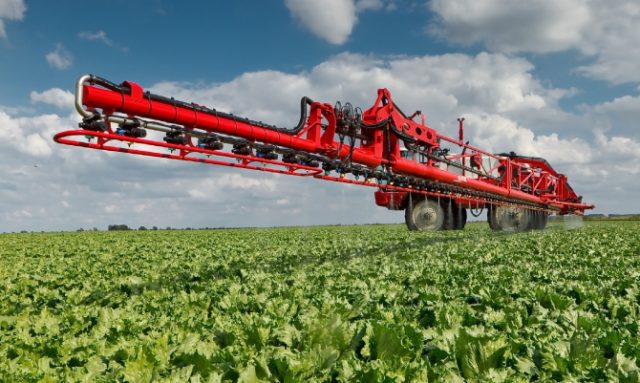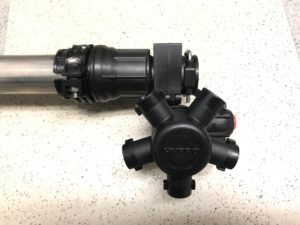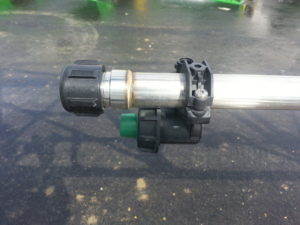
As the spraying season recedes in the rear-view mirror, it’s a good time to think about how the season went and what the most memorable moments were for you. Did you have a drift issue? A tank clean-out mistake? Did your products work as expected, and if not, do you know why? Did you lose too much time getting the sprayer filled, or unplugging nozzles?
Noting these events might give you an idea what to research over the trade show season, and what you might be able to change for next year. Some of our biggest struggles in spraying involve the start and end of each spray day. These are prime candidates for improvement.
At the end of a spray day, we should ideally clean the sprayer. During that process, we may struggle with where to put the waste product, including large rinsate amounts, and of course, the uncertainty of whether the job is actually done (since clean water looks exactly the same as contaminated water).
If we’re not prepared to clean the entire sprayer plumbing, we should at least rinse the boom with water. This can prevent future problems, especially with products formulated as suspensions or emulsifiable concentrates which can settle and cling to various sprayer parts.
When starting a new field after the sprayer is cleaned and the boom has water in it, we need to prime the boom. Air purge is very useful in those instances. But without air, the question is how long to purge for, and where best to do this (pro tip at bottom of article).
These straightforward tasks are complicated by the increasingly convoluted plumbing featured on modern sprayers. Ask someone to explain their sprayer’s plumbing system to you one day. It’s a long story! Better engineered systems would be welcome.
Fortunately, virtually any sprayer can be modified to suit your needs. Let’s talk about a few ideas for a winter project:
- Boom flush. It’s good practice to flush clean water through your boom at the end of spraying even if the main tank remains full of product. Some sprayers have an air purge system to eliminate liquid from the plumbing and that is a great feature. A water flush should follow that purge so that any residual pesticide is diluted and removed before it can dry on and become hard to remove later. First you’ll need a clean water tank on the sprayer (150 gallons is enough). Second, plumb a feed so that this clean tank can be the sole source of the water supplied to the solution pump. Select this source, shut return lines down or off, and pump clean water through boom. Idling the engine to avoid pressure spikes may be necessary. Sprayers that have an auto-rinse cycle will likely be able to draw clean water, but may not be able to push it to the boom, directing it to the wash-down nozzles instead. Check to see what’s possible, and make the changes you need.
- Clean water pump. Installing a second pump dedicated to the clean water tank has several advantages. We’ve talked about “continuous rinsing” before on Sprayers101.com as a way to dilute the tank remainder faster. The idea is to speed up and improve the quality of rinsing the system.
Continuous rinsing starts by spraying the product tank completely empty in the field, possibly by returning over a previously sprayed swath at a lower application rate. Once the tank is empty and spray pressure drops, turn on the second pump, keeping agitation and purge lines open. This pump now delivers clean water to the tank via the wash-down nozzles. The solution pump soon regains pressure, and delivers the rinsate to the boom and the return lines.
The key to this system is to closely match the wash-down pump volume to the application rate. If the sprayer is delivering 20 gpm to the boom, the wash-down nozzle should be close to that. Under-delivering with the wash down is better than over-delivering, because the latter allows spray rinsate to accumulate in the tank, making dilution less effective.
The wash-down nozzles have to be able to handle the incoming water rate and still function as intended. This will likely require some observation and tweaking.
When the clean water tank is empty a few minutes later, the main tank will be rinsed and the rinsate in the return lines and boom will be very dilute, more dilute than even a triple rinse would have achieved. And the whole process didn’t require any stopping and dismounting of the sprayer.
Additionally, give this pump the option to deliver water just to the boom without using the wash-down nozzles. Now it can be used to rinse water through the boom.
Continuous rinsing is just one of the steps in sprayer clean out. Cleaning strainers, boom ends and other sprayer parts are just as important.
- Boom ends. We’ve mentioned this part of the boom many times. Boom ends that extend beyond the last nozzle on each end of a section must be flushed regularly to get rid of product and debris that gets stuck there. Many producers install ball valves to achieve this, but must do so regularly. A simpler way is to use the Express Nozzle Body End Caps from Hypro. These bleed air continuously, and also prevent accumulation of dead-end contamination. They do need to be flushed, and this can be done by pulling a plug or rotating the turret to an open (no nozzle) position.
- Recirculating boom. This is a significant change, but worth considering. Conventional plumbed booms are separated into five to 13 sections. Each has two ends at which the spray stops and where air and contamination can accumulate (see point #3). Each section feed has a shut-off valve, controlled via the rate controller. Once the spray mixture leaves the pump and bypass valve, it is committed to leaving the sprayer.
In a recirculating boom, the boom is a single section and its entire volume can become a part of the tank. In other words, the liquid can return to the tank if desired. Spray is pressurized and fed to one or both ends of the boom. Valve positions determine its flow, either forcing it out through the open nozzles, or returning it to the tank. Sectional control is achieved with individual nozzle shut off, either using air or electric solenoids.
- Three advantages:
(a) the boom can be primed with new product without spraying. The surplus goes back to the tank.
(b) the boom can be flushed with water without spraying while material is still in tank, and without spilling anything on the ground. Again, the surplus goes back to the tank.
(c) high-resolution sectional control with individual nozzle shut off is a byproduct of this design. Fast response, high res, saves money.
This design does have some challenges. In designs where the boom is fed just from one end, a significant volume of spray mix is returned to the tank for dilution. Designs where the boom can be pressurized on both ends address this issue.
- Steel lines. Steel cleans easier than plastic, and this material makes a lot of sense for booms. But it also makes sense for the boom feeds, currently handled by black rubber hose. This hose is a literal black box. We can’t see inside it, and we don’t know if and where potential contamination resides. It has considerable surface area. Consider replacing portions of your feed lines with steel. The boom is the obvious candidate. Aside from easier clean out, it also helps with faster nozzle shut off because it doesn’t expand with pressure.
A word about dumping the tank remainder on the ground. It’s a bad practice for many reasons. Let’s examine just one of those. When you spray a product at 10 gpa, you actually cover each square metre with about 10 ml of spray mix. When you flush your boom ends on the ground, you’re probably dropping two or three gallons in the same area. That’s 1,000 times the label rate at each boom end, 10 to 26 times per boom. If you dump your tank remainder and all the hoses, say 20 or 30 gallons, that’s 10,000 times the label rate if it covers one square metre. That’s leaching, run-off, residual potential, and not a good story.
Many of the changes outlined above help prevent that from being necessary.
Pro Tip: To find out how much water your plumbing (from the pump to the boom ends) holds, do this: After cleaning with water (and without an air purge) use an EC formulation as a marker. ECs have a white milky appearance (some crop oils are ECs). Reset your sprayed gallons on your rate controller. Start spraying and watch for the last nozzle on your furthest and longest section to spray white. Stop spraying and check your sprayed gallons. That’s your volume. No matter the size of nozzle or application volume, it stays constant. To be sure the boom is primed with a new mix, spray until those gallons are reached and you’re set.












